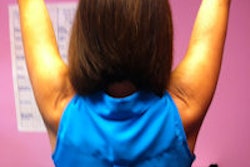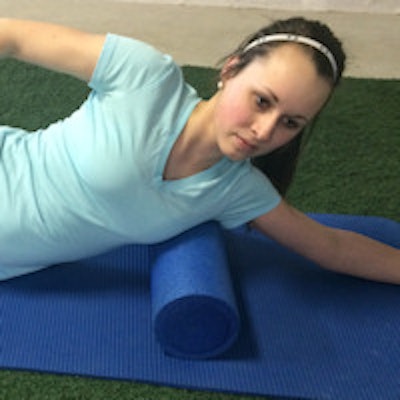
With the combination of a heavy work schedule and the physical demands of the job, many sonographers find that their bodies start to fall apart. To combat the resulting pain and fatigue from achy knees, stiff backs, and painful shoulders, you need to use recovery techniques proactively.
Foam rollers have become increasingly popular over the past few years, being adopted by therapists, athletes, and the general population alike. Used before and after workouts, the rolling applies pressure to certain "trigger points," enabling the muscles to relax and the body to function better and like it should.
While foam rollers are a great recovery and release tool, they can be less effective for common trouble spots in the lower legs, hips, and shoulders. Luckily, there are additional tools in the toolbox, such as foam balls, bumpy rollers, and more, that can reach every nook and cranny on our body. It may seem silly to the uninitiated, but these new tools facilitate a variety of advanced exercises that can quickly, easily, and effectively target some of your harder-to-reach muscles.
How we work, play, and train can tax the muscles in our feet, ankles, hips, back, and shoulders. We discuss some trouble areas below and what steps you can take to get relief and keep pain away.
Arches
Our feet take a beating every day. This is probably our favorite drill and can be done anywhere. Rolling a ball along the arches (figures 1 and 2) can help break up tension in the foot and feels great. (Note: You can use a tennis ball to get started with this exercise and progress to a basic lacrosse ball. Move from a ball that has some give to a firmer ball. You can work up to using a golf ball.)
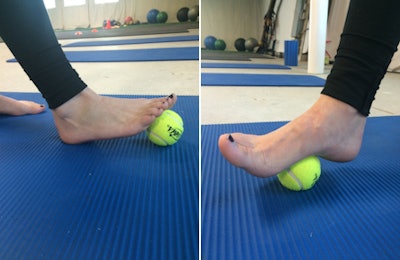 Figures 1 and 2. All images courtesy of Doug Wuebben.
Figures 1 and 2. All images courtesy of Doug Wuebben.Soleus
Located just above the Achilles tendon, the soleus often gets tight from running and moving around. Using a small ball or roller elevated on a block (figure 3), allow the roller to dig into the soleus and then rotate the foot in circles. The combination of compression and movement allows the roller or ball to do its thing. Try a few different spots, as well as moving your toes. If this is too much too soon, you can start with the ball on the ground, letting the heel help to determine the amount of pressure on the soleus.
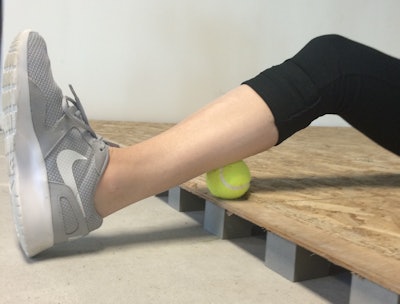 Figure 3.
Figure 3.Tibialis anterior
This is the small muscle in the front of your lower leg. Often overlooked, it is commonly overworked in runners and athletes, as well as people just getting into a new exercise program. Think shin splints!
With this drill, you can stretch the tibialis anterior in a number of different ways. Kneel on a foam roller, placing the roller on your shins, and move back and forth (figure 4). As shown in figure 5, you can also use a "roll stick" -- a fitness tool similar to a kitchen rolling pin.
Finally, you can also lace your fingers around a ball, pull it into the muscle, elevate the foot, and make small circles with the ball and the foot. Again, combine compression with movement to target the muscle.
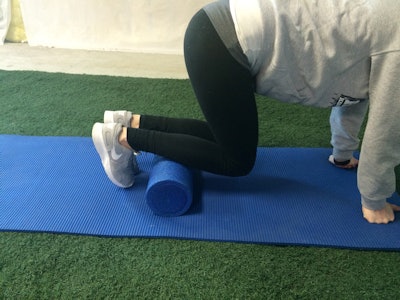 Figure 4.
Figure 4.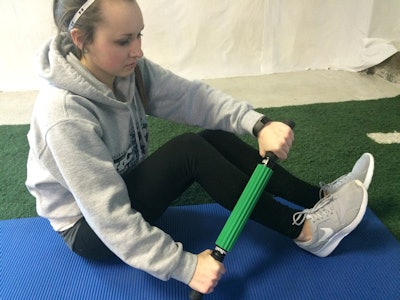 Figure 5.
Figure 5.Quadriceps
Common foam rollers are great, but a roller with bumps (such as in figure 6) provides some variety. Instead of simply rolling on the muscle, lie over the roller with bumps (figure 7) and then twist (figure 8). This allows the bumps on the roller to work the muscle in a new way. The bump roller is one of our favorites for the quads.
 Figure 6.
Figure 6.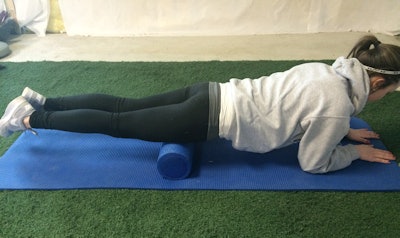 Figure 7.
Figure 7.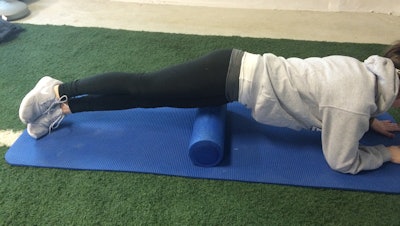 Figure 8.
Figure 8.Hip flexor/psoas
Sitting is the new smoking. The combination of sitting for long periods of time and extensive front-side repetitive motion can leave your hip flexors a bit stiff and immobile. Progressing from a foam ball to a tennis ball and then a firmer ball allows you to get into the crease of the hip and groin to work on these overactive muscles (figure 9). Place the ball on one side, in the "pocket area," or in the fold of the hip -- and roll!
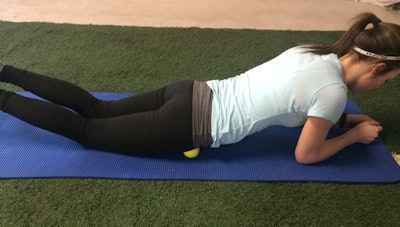 Figure 9.
Figure 9.Glute/piriformis
This drill uses a small ball, placed in the center of the glute (butt). Lean onto your elbow and draw your knee up toward the body (figure 10). Careful on this one, it's an eye-opener! We typically begin with a tennis ball and progress to denser balls over time.
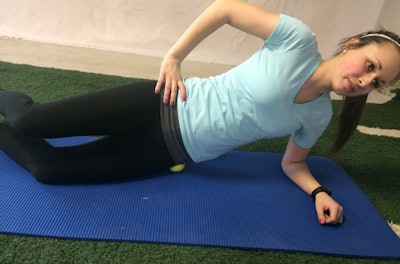 Figure 10.
Figure 10.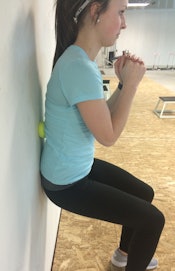 Figure 11.
Figure 11.Erector spinae (back)
This drill uses two tennis balls taped together and is performed by rolling up the center of the back. The balls dig into the erector muscles along the spine without hitting the spine directly. It's a lifesaver for people who spend a lot of time hunched over a desk, in the car, on the couch, or doing repetitive motion at work.
It's easy to make the equipment for this drill, and you can do it against a wall (figure 11), on the floor, or up against the door in your office.
Pectoralis (chest)
The pec rolling drill is beneficial for just about everyone. Most of us have hunched shoulders, and a tight chest is one of the main culprits. We typically use the foam therapy ball, but you can also use a tennis ball (figure 12) or a lacrosse ball. We even have beginners start with a larger ball (figure 13).
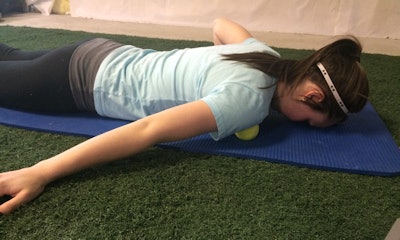 Figure 12.
Figure 12.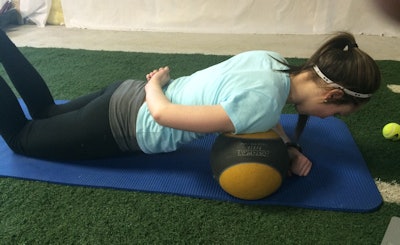 Figure 13.
Figure 13.Latissimus dorsi (upper back)
Just like for the quads, you can use a typical foam roller on the lats. However, we prefer the roller with bumps to address this muscle; you can get in deeper and get more release. Try to roll across the muscle and from top to bottom (figure 14).
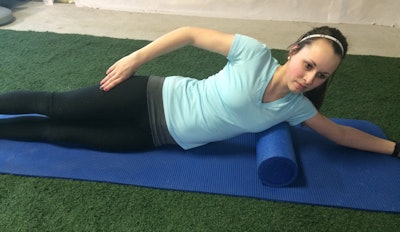 Figure 14.
Figure 14.Shoulder
This can be a tender area, so start with the foam roller if you've never done it before (figure 15). After that, you can progress to the foam therapy ball or a tennis ball (figure 16). This exercise hits all of the small muscles that tie the shoulder together, including the rotator-cuff muscles and deltoids, and will loosen up your shoulder.
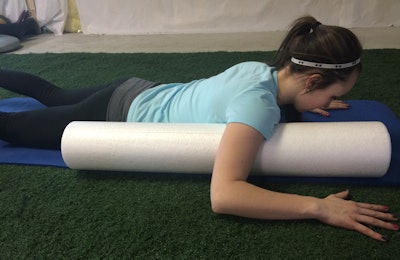 Figure 15.
Figure 15.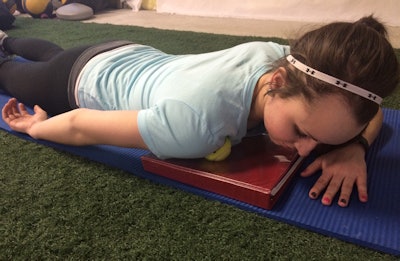 Figure 16.
Figure 16.Back/shoulder release
We love this one to finish up. Simply take the foam roller and place it down your spine. Let everything relax, and allow your shoulders to drop and your arms to rest on the ground. Let the hips relax and drop to the floor. You can also put the roller across the back/shoulder blades and let your hips drop to relieve tension through the body.
Incorporating foam rolling
Be sure to try all of these drills, but you don't have to do them all at one time. Starting out, you may find that some of them make you feel sore and stiff, while others feel unnecessary. After identifying your trouble spots, it only takes about five to 10 minutes to address these areas.
Mark Roozen's Beyond Foam Rolling drills are a perfect prewarmup to keep your body moving and healthy. These are quick, easy, and effective release drills that anybody can do to get relief. You don't need to join a gym, and all the materials are inexpensive to purchase. Your body will thank you for it later.
Doug Wuebben is a registered echocardiographer and also a consultant, national presenter, and author of e-books in the areas of ergonomics, exercise and pain, and injury correction for sonographers. He has also been published on the topics of telemedicine and achieving lab accreditation. Mark Roozen is a strength and performance coach and also the owner and president of Performance Edge Training Systems (PETS). Wuebben and Roozen are co-founders of Live Pain Free -- The Right Moves. Email [email protected] or go to coachrozy.com for more information on programs or speaking requests or if you have any questions or comments.
The comments and observations expressed herein are those of the authors and do not necessarily reflect the opinions of AuntMinnie.com.





